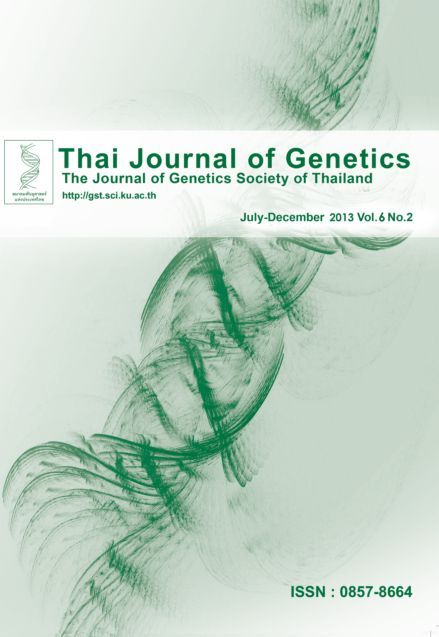เทคนิคโปรตีโอมิกสำหรับการวิเคราะห์วิถีชีวสังเคราะห์สารพิษในสบู่ดำ
DOI:
https://doi.org/10.14456/tjg.2013.117Keywords:
Jatropha curcas, phorbol esters, proteomicsAbstract
Phorbol esters (PEs) are main toxins found in several parts of Jatropha curcas. The amount of PEs in Jatropha curcas differ by species depending on the climate and soil in each area. PEs are known to promote tumor growth and are poisonous to humans and animals. Several utilizations of Jatropha oil and Jatropha kernel meal obtained after oil extraction are therefore restricted. In this work, protein expression in Jatropha curcas fruits was studied to understand PEs biosynthetic pathway and its related pathway. Proteomics is a technique used to analyse changes in quantity and quality of protein expression with high efficiency and accuracy. The use of proteomics approach to study changes of PEs biosynthetic proteins in fruits would be highly beneficial in Jatropha curcas breeding to reduce PEs in the future.
References
รักษ์ พฤกษชาติ (2552) การปลูกและการพัฒนาสบู่ดำเพื่อทดแทนน้ำมันดีเซล. สำนักพิมพ์ นีออน บุ๊ค มีเดีย กรุงเทพฯ
Ahmed AW and Salimon J (2009) Phorbol ester as toxic constituents of tropical Jatropha curcas seed oil. Eur J Sci Res 31: 429–436.
Booranasrisak T, Phaonakrop N, Jaresitthikunchai J, Virunanon C, Roytrakul S and Chulalaksananukul W (2013) Proteomic evaluation of free fatty acid biosynthesis in Jatropha curcas L. (physic nut) kernel development. Afr J Biotechnol 12: 3132–3142.
Caballero NG, Vega AR, Lopes GD, Valenzuela JG, Ribeiro JMC, Carvalho PC, Valente RH, Brazil RP and Cuervo P (2014) Expression of the mevalonate pathway enzymes in the Lutzomyia longipalpis (Diptera: Psychodidae) sex pheromone gland demonstrated by an integrated proteomic approach. J Proteome Res 96: 117–132.
Devappa RK, Makkar HPS and Becker K (2010a) Jatropha toxicity: a review. J Toxicol Environ Health B Crit Rev 13: 476–507.
Devappa RK, Makkar HPS and Becker K (2010b) Optimization of conditions for the extraction of phorbol esters from Jatropha oil. Biomass Bioenerg 34: 1125–1133.
Devappa RK, Makkar HPS and Becker K (2011) Jatropha diterpenes: a review. J Am Oil Chem Soc 88: 301–322.
Goel G, Makkar HPS, Francis G and Becker K (2007) Phorbol esters: Structure, biological activity and toxicity in animals. Int J Toxicol 26: 279–288.
Gürtler A, Kunz N, Gomolka M, Hornhardt S, Friedl AA, McDonald K, Kohn JE and Posch A (2013) Stain-Free technology as a normalization tool in Western blot analysis. Anal Biochem 433: 105–111.
Haas W, Sterk H and Mittelbach M (2002) Novel 12-Deoxy-16-hydroxyphorbol Diesters isolated from the seed oil of Jatropha curcas. J Nat Prod 65: 1434–1440.
Kirby J, Nishimoto M, Park JG, Withers ST, Nowroozi F, Behrendt D, Rutledge EJG, Fortman JL, Johnson HE, Anderson JV, et al. (2010) Cloning of casbene and neocembrene synthases from Euphorbiaceae plants and expression in Saccharomyces cerevisiae. Phytochemistry 71: 1466–1473.
Lin J, Jin Y, Zhou M, Zhou X and Wang J (2009) Molecular cloning, characterization and functional analysis of a 3-hydroxy-3-methylglutaryl coenzyme A reductase gene from Jatropha curcas. Afr J Biotechnol 8: 3455–3462.
Lin J, Jin Y, Zhou X and Wang J (2010) Molecular cloning and functional analysis of the gene encoding geranylgeranyl diphosphate synthase from Jatropha curcas. Afr J Biotechnol 9: 3342–3351.
Liu H, Liu YJ, Yang MF and Shen SH (2009) A comparative analysis of embryo and endosperm proteome from seeds of Jatropha curcas. J Integr Plant Biol 51; 850–857.
Liu H, Yang Z, Yang M and Shen S (2011) The differential proteome of endosperm and embryo from mature seed of Jatropha curcas. Plant Sci 181: 660–666.
Miziorko HM (2011) Enzymes of the mevolonate pathway of isoprenoid biosynthesis. Arch Biochem Biophys 505: 131–143.
Nakano Y, Ohtani M, Polsri W, Usami T, Sambongi K and Demura T (2012) Characterization of the casbene synthase homolog from Jatropha (Jatropha curcas L.). Plant Biotechnol 29: 185–189.
Newton RP, Brenton AG, Smith CJ and Dudley E (2004) Review: Plant proteome analysis by mass spectrometry: principles, problems, pitfalls and recent developments. Phytochemistry 65: 1449–1485.
Nieto B, Forés O, Arró M and Ferrer A (2009) Arabidopsis 3-hydroxy-3-methylglutaryl-CoA reductase is regulated at the post-translational level in response to alterations of the sphingolipid and the sterol biosynthetic pathways. Phytochemistry 70: 53–59.
Sabandar CW, Ahmat N, Jaafar FM and Sahidin I (2013) Medicinal property, phytochemistry and pharmacology of several Jatropha species (Euphorbiaceae): A review. Phytochemistry 85: 7–29.
Siang TC, Soong ST and Yien ATS (2012) Plant regeneration studies of Jatropha curcas using induced embryogenic callus from cotyledon explants. Afr J Biotechnol 11: 8022–8031.
Sujatha M and Mukta N (1996) Morphogenesis and plant regeneration from tissue culture of Jatropha curcas. Plant Cell Tissue Organ Cult 44: 135–141.
Thelen JJ (2013) Proteomics tools and resources for investigating protein allergens in oilseeds. Regul Toxicol Pharmacol 54: S41–S45.
Vanderschuren H, Lentz E, Zainuddin I and Gruissem W (2013) Proteomics of model and crop plant
species: Status, current limitations and strategic advances for crop improvement. J Proteomics 93: 5–19.
Vickers CE, Gershenzon J, Lerdau MT and Loreto F (2009) A unified mechanism of action for volatile
isoprenoids in plant abiotic stress. Nat Chem Biol 5: 283–291.
Wei H (2011) Biochemical and genetic analyses of Jatropha curcas L. seed composition. Department of biology University of York. PhD Thesis.
Xu R, Wang R and Liu A (2011) Expression profiles of genes involved in fatty acid and triacylglycerol synthesis in developing seeds of Jatropha (Jatropha curcas L.). Biomass Bioenerg 35: 1683–1693.
Yang MF, Liu YJ, Liu Y, Chen H, Chen F and Shen SH (2009) Proteomic analysis of oil mobilization in seed germination and postgermination development of Jatropha curcas. J Proteome Res 8: 1441–1451.
Yunping B, Ha BTN, Eunice Y, Chueng LL and Yan H (2012) Light induced degradation of phorbol esters. Ecotoxicol Environ Saf 84: 268–273.


